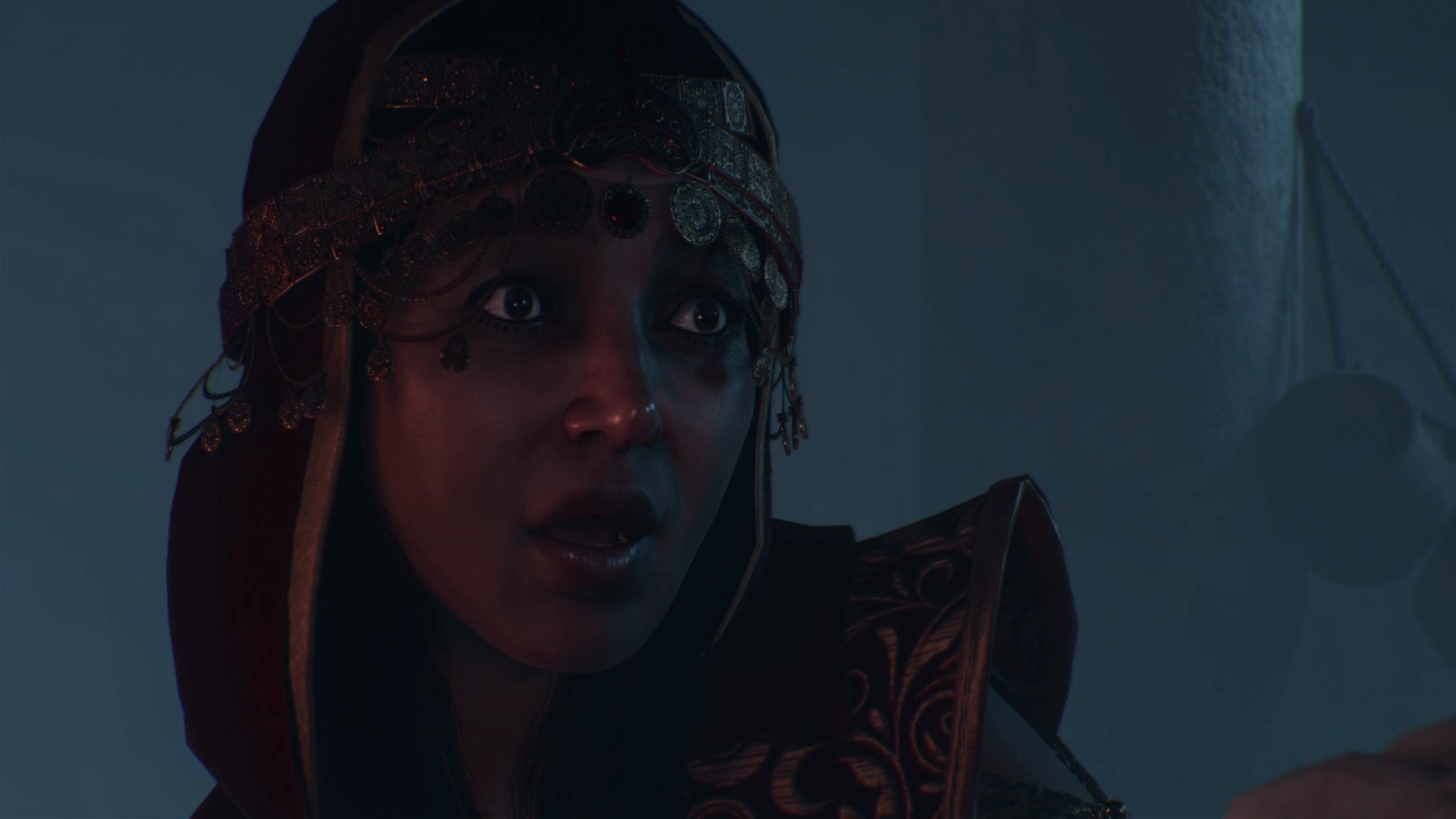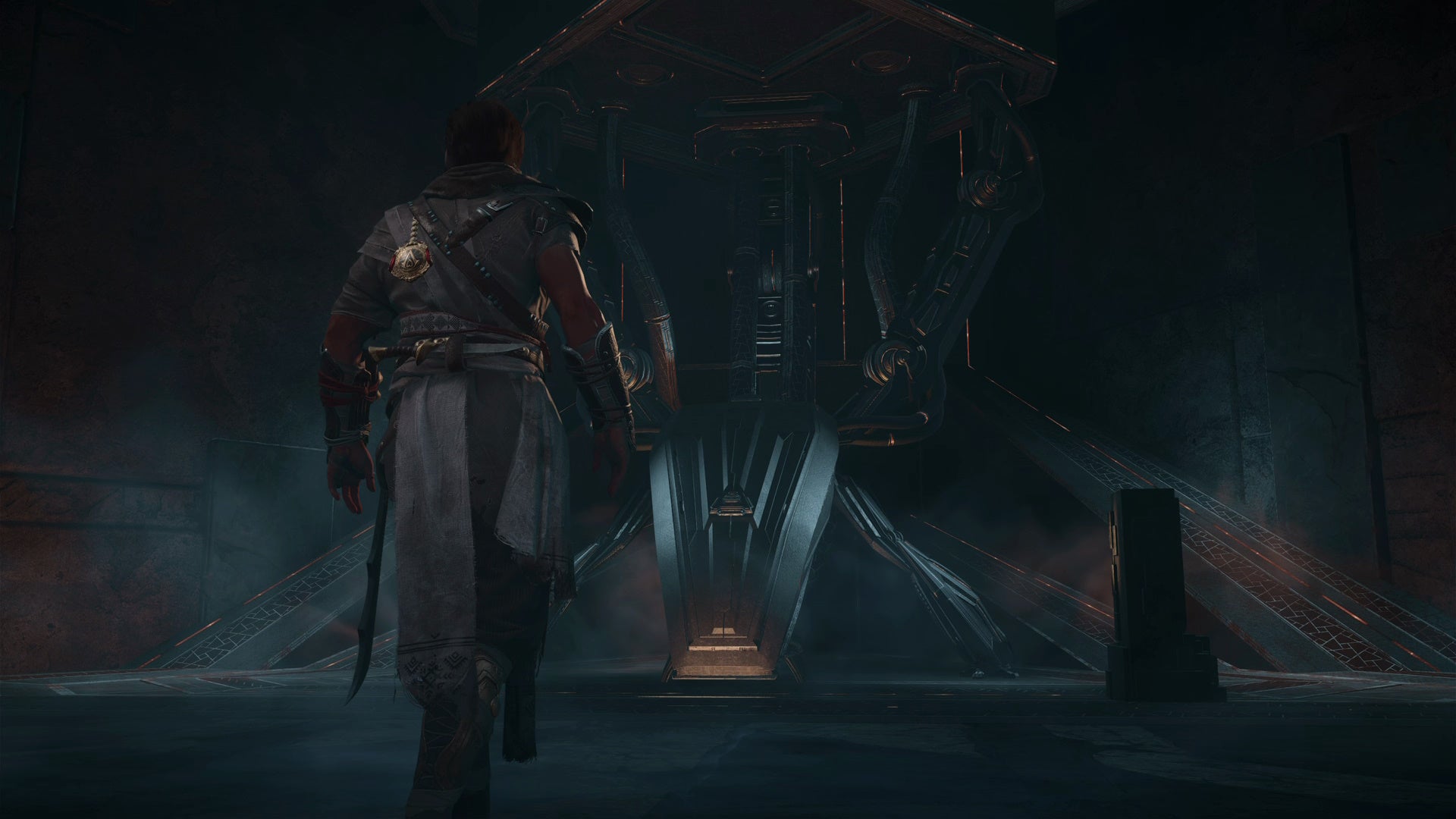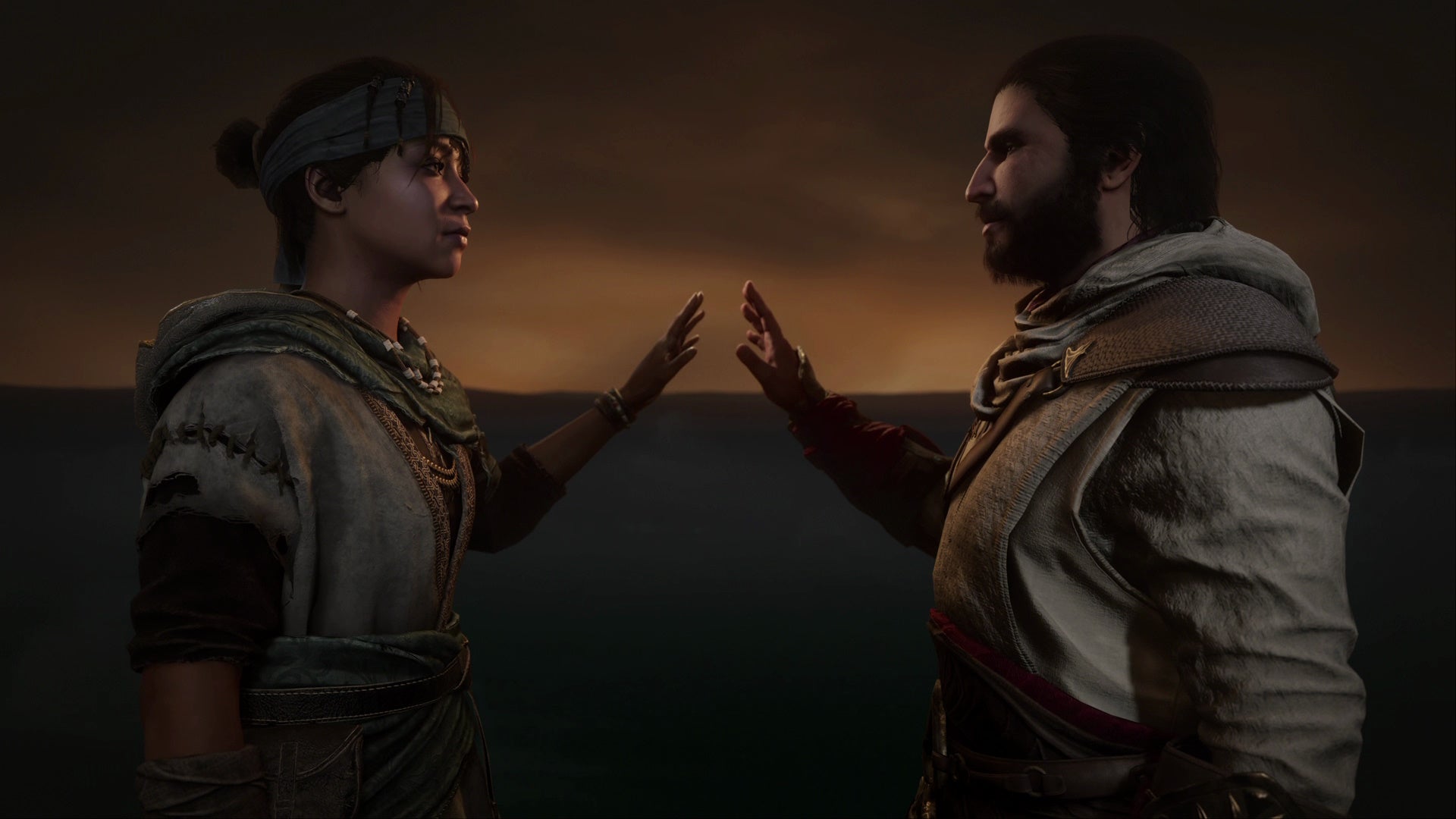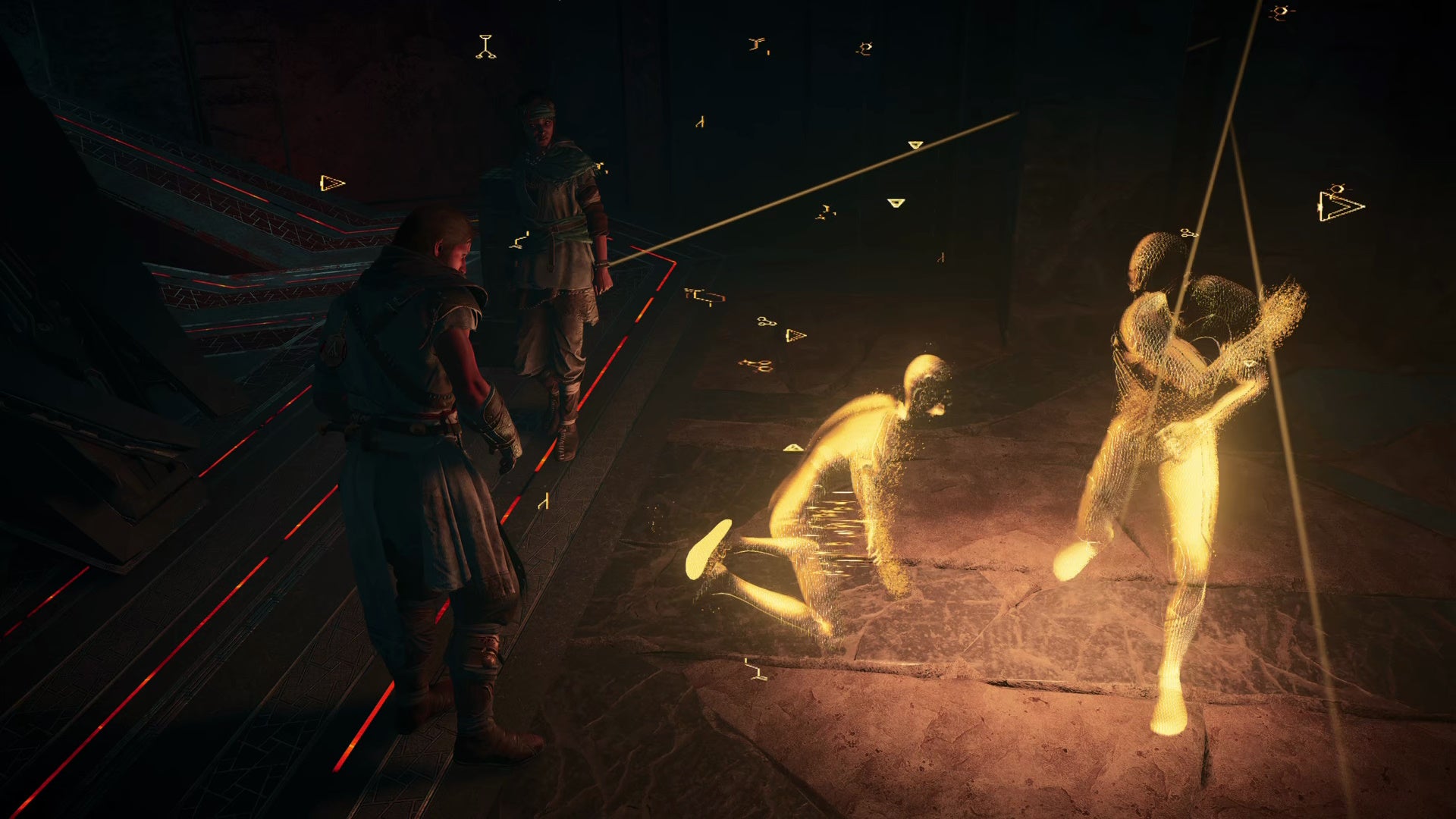Warning: this article contains full spoilers for the ending of Assassin's Creed Mirage.
Assassin’s Creed Mirage takes us all the way back to 9th century Baghdad to live the origin story of Basim. We first met Basim in Assassin’s Creed Valhalla, and Mirage connects back to that game in a couple of important ways. To explore how those connections are forged, as well as answer any lingering questions, we’re going to fully break down the ending of Assassin’s Creed Mirage. Full spoilers are ahead, so leap away now if you haven’t finished the game or don’t want to know.

Basim’s quest to cut off the head of the snake brings him to the Palace of the Green Dome. Here he comes face to face with Al-Bahamut, the leader of the Order in Baghdad. They are revealed to be Qabiha, the concubine of the Caliph who was killed by Nehal during the prologue. But it turns out that Qabiha has been hunting for Basim as much as he has been hunting her.
Qabiha’s son, Abu ‘Abdallah, saw the ancient disc activate when young Basim touched it in the palace. He told his mother what he saw, and so for years Qabiha has known that Basim is connected to the Isu; an ancient civilisation that ruled the world before the era of humanity. And so she attempts to coerce him, promising that he will learn everything of who he is in a secret chamber beneath the Hidden Ones’ temple of Alamut. But before she can say anymore, Roshan assassinates her. The master assassin warns Basim that if he goes looking for answers she will kill him.

Angered by Roshan’s actions, Basim and Nehal journey to Alamut. Beneath the temple, Basim discovers that his touch awakens a stone wall, which fades away to reveal a technologically advanced vault door. Roshan interrupts and tries to prevent Basim from proceeding but he defeats her in combat.
Nehal teaches Basim how to open the vault door with his blood and a deep chamber is revealed. The architecture is clearly Isu in design, similar to what we’ve seen in many other Assassin’s Creed games. Inside, Basim discovers a prison with a sarcophagus at its centre. He opens the sarcophagus, only to find Nehal inside.

It is revealed that Nehal is actually Basim. In a Fight Club-like twist, it turns out that she’s an aspect of Basim’s personality that manifests as an imaginary friend. And so everything Nehal did, Basim did – right down to killing the Caliph.
And this is where Mirage connects to Assassin’s Creed Valhalla. In Valhalla, we learned that Basim is actually the reincarnation of Loki. Nehal represents the memories of the original Loki locked away inside Basim. Okay, yeah, this is going to take a bit of explaining…
In Assassin’s Creed lore, the ancient Isu civilization is the inspiration for human mythology. Loki was part of the Aesir branch of the Isu, which directly influenced Norse mythology. Thousands of years ago, the Isu were threatened by an apocalypse event, and so they developed a supercomputer called Yggdrasill to help them survive it. The Aesir Isu uploaded their consciousness onto Yggdrasill, which would then distribute them into the human gene pool centuries later. This effectively allowed the Aesir to leapfrog over the apocalypse and be reborn again in human bodies.
The name Nehal is derived from the Persian language, and means “newly planted tree”. Thus Nehal is Yggdrasill’s newly planted seed of Loki.

In the Isu chamber, Nehal uses the ancient disc to activate a hologram. This suggests that the disc is similar to a Memory Seal, an Isu device that stores memories.
The hologram depicts two figures; a prisoner and a jailor. The prisoner is shown to be Basim, while the jailor is the jinni; a supernatural spectre that has haunted Basim all throughout the game. Basim realises that the jinni represents the torture he endured in this prison during his previous life as Loki. He makes peace with these dark memories, destroying the jinni’s hold over him.
So if the prisoner hologram is Basim, and thus represents the experiences of Loki during the Isu era, then who is the jailor? For that, we can look to the Norse myths that have inspired this part of the Assassin’s Creed story. In the mythology, Loki is taken into a cave and bound to a stone as punishment for his involvement in the poisoning of Baldr, son of All-father Odin. During the events of both Assassin’s Creed Valhalla and its expansion, Dawn of Ragnarok, we learn that the Isu version of Loki also orchestrated Baldr’s poisoning. It seems sensible to assume, then, that this Isu chamber is the Assassin’s Creed version of the binding of Loki myth. And so the jailor is almost certainly Odin.
And who is Odin? Well, none other than Eivor, the human reincarnation of the All-father and protagonist of Assassin’s Creed Valhalla.

After making peace with his memories of being imprisoned and tortured, Basim becomes one with Nehal. This symbolises the merging of Basim’s human body and Loki’s consciousness. Loki has now been fully restored and reincarnated.
We can see that Basim has fully transformed into Loki when his eagle, Enkidu, rejects him. Animals are generally considered to be highly intelligent and sensitive, and so we can see here Enkidu sensing the evil trickster within their master.
In the final scene, Basim swears vengeance on those who tortured him should they walk this earth. This foreshadows his quest to find and kill Odin, which will bring him to Eivor during the events of Assassin’s Creed Valhalla.
And that’s the ending of Assassin’s Creed Mirage explained. For more, check out our review, as well as how long it took us to finish the game.
Continue reading...
Assassin’s Creed Mirage takes us all the way back to 9th century Baghdad to live the origin story of Basim. We first met Basim in Assassin’s Creed Valhalla, and Mirage connects back to that game in a couple of important ways. To explore how those connections are forged, as well as answer any lingering questions, we’re going to fully break down the ending of Assassin’s Creed Mirage. Full spoilers are ahead, so leap away now if you haven’t finished the game or don’t want to know.

The Head of the Snake
Basim’s quest to cut off the head of the snake brings him to the Palace of the Green Dome. Here he comes face to face with Al-Bahamut, the leader of the Order in Baghdad. They are revealed to be Qabiha, the concubine of the Caliph who was killed by Nehal during the prologue. But it turns out that Qabiha has been hunting for Basim as much as he has been hunting her.
Qabiha’s son, Abu ‘Abdallah, saw the ancient disc activate when young Basim touched it in the palace. He told his mother what he saw, and so for years Qabiha has known that Basim is connected to the Isu; an ancient civilisation that ruled the world before the era of humanity. And so she attempts to coerce him, promising that he will learn everything of who he is in a secret chamber beneath the Hidden Ones’ temple of Alamut. But before she can say anymore, Roshan assassinates her. The master assassin warns Basim that if he goes looking for answers she will kill him.

The Isu Chamber
Angered by Roshan’s actions, Basim and Nehal journey to Alamut. Beneath the temple, Basim discovers that his touch awakens a stone wall, which fades away to reveal a technologically advanced vault door. Roshan interrupts and tries to prevent Basim from proceeding but he defeats her in combat.
Nehal teaches Basim how to open the vault door with his blood and a deep chamber is revealed. The architecture is clearly Isu in design, similar to what we’ve seen in many other Assassin’s Creed games. Inside, Basim discovers a prison with a sarcophagus at its centre. He opens the sarcophagus, only to find Nehal inside.

Nehal is Basim
It is revealed that Nehal is actually Basim. In a Fight Club-like twist, it turns out that she’s an aspect of Basim’s personality that manifests as an imaginary friend. And so everything Nehal did, Basim did – right down to killing the Caliph.
And this is where Mirage connects to Assassin’s Creed Valhalla. In Valhalla, we learned that Basim is actually the reincarnation of Loki. Nehal represents the memories of the original Loki locked away inside Basim. Okay, yeah, this is going to take a bit of explaining…
In Assassin’s Creed lore, the ancient Isu civilization is the inspiration for human mythology. Loki was part of the Aesir branch of the Isu, which directly influenced Norse mythology. Thousands of years ago, the Isu were threatened by an apocalypse event, and so they developed a supercomputer called Yggdrasill to help them survive it. The Aesir Isu uploaded their consciousness onto Yggdrasill, which would then distribute them into the human gene pool centuries later. This effectively allowed the Aesir to leapfrog over the apocalypse and be reborn again in human bodies.
The name Nehal is derived from the Persian language, and means “newly planted tree”. Thus Nehal is Yggdrasill’s newly planted seed of Loki.

The Isu Holograms
In the Isu chamber, Nehal uses the ancient disc to activate a hologram. This suggests that the disc is similar to a Memory Seal, an Isu device that stores memories.
The hologram depicts two figures; a prisoner and a jailor. The prisoner is shown to be Basim, while the jailor is the jinni; a supernatural spectre that has haunted Basim all throughout the game. Basim realises that the jinni represents the torture he endured in this prison during his previous life as Loki. He makes peace with these dark memories, destroying the jinni’s hold over him.
So if the prisoner hologram is Basim, and thus represents the experiences of Loki during the Isu era, then who is the jailor? For that, we can look to the Norse myths that have inspired this part of the Assassin’s Creed story. In the mythology, Loki is taken into a cave and bound to a stone as punishment for his involvement in the poisoning of Baldr, son of All-father Odin. During the events of both Assassin’s Creed Valhalla and its expansion, Dawn of Ragnarok, we learn that the Isu version of Loki also orchestrated Baldr’s poisoning. It seems sensible to assume, then, that this Isu chamber is the Assassin’s Creed version of the binding of Loki myth. And so the jailor is almost certainly Odin.
And who is Odin? Well, none other than Eivor, the human reincarnation of the All-father and protagonist of Assassin’s Creed Valhalla.

The Future
After making peace with his memories of being imprisoned and tortured, Basim becomes one with Nehal. This symbolises the merging of Basim’s human body and Loki’s consciousness. Loki has now been fully restored and reincarnated.
We can see that Basim has fully transformed into Loki when his eagle, Enkidu, rejects him. Animals are generally considered to be highly intelligent and sensitive, and so we can see here Enkidu sensing the evil trickster within their master.
In the final scene, Basim swears vengeance on those who tortured him should they walk this earth. This foreshadows his quest to find and kill Odin, which will bring him to Eivor during the events of Assassin’s Creed Valhalla.
And that’s the ending of Assassin’s Creed Mirage explained. For more, check out our review, as well as how long it took us to finish the game.
Continue reading...


